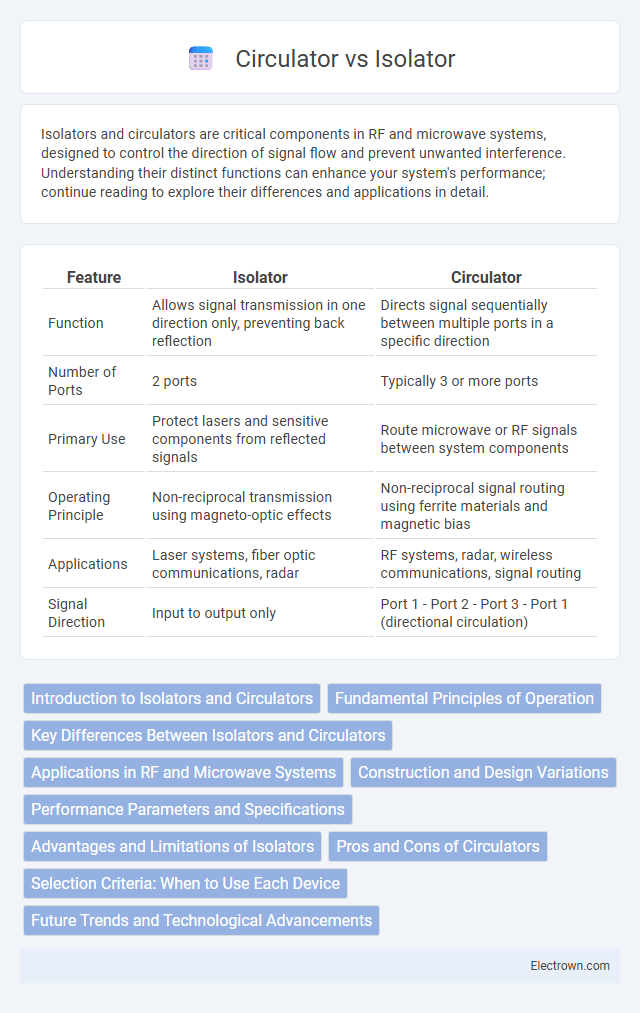Isolators and circulators are critical components in RF and microwave systems, designed to control the direction of signal flow and prevent unwanted interference. Understanding their distinct functions can enhance your system's performance; continue reading to explore their differences and applications in detail.
Table of Comparison
| Feature | Isolator | Circulator |
|---|---|---|
| Function | Allows signal transmission in one direction only, preventing back reflection | Directs signal sequentially between multiple ports in a specific direction |
| Number of Ports | 2 ports | Typically 3 or more ports |
| Primary Use | Protect lasers and sensitive components from reflected signals | Route microwave or RF signals between system components |
| Operating Principle | Non-reciprocal transmission using magneto-optic effects | Non-reciprocal signal routing using ferrite materials and magnetic bias |
| Applications | Laser systems, fiber optic communications, radar | RF systems, radar, wireless communications, signal routing |
| Signal Direction | Input to output only | Port 1 - Port 2 - Port 3 - Port 1 (directional circulation) |
Introduction to Isolators and Circulators
Isolators and circulators are essential non-reciprocal microwave components used in RF and microwave systems to control signal flow. Isolators allow signals to pass in one direction while preventing reflections or unwanted feedback, protecting sensitive equipment from damage and interference. Circulators route signals sequentially between multiple ports, enabling signal routing and switching without loss, crucial for antenna duplexing and complex microwave circuits.
Fundamental Principles of Operation
Isolators operate on the principle of non-reciprocal transmission, allowing signals to pass in only one direction by using magneto-optic effects such as the Faraday rotation. Circulators leverage similar non-reciprocal behavior but utilize multiple ports to route signals sequentially from one port to the next in a cyclic manner, often employing ferrite materials under a static magnetic field. Both devices rely on the manipulation of electromagnetic wave polarization and phase to achieve direction-dependent transmission, critical for protecting sensitive components and managing signal flow in RF and microwave systems.
Key Differences Between Isolators and Circulators
Isolators and circulators serve distinct purposes in microwave and RF systems by controlling signal direction with different mechanisms. An isolator permits unidirectional signal flow to protect sensitive components from reflected power, while a circulator routes signals sequentially between multiple ports to facilitate signal routing without interference. Understanding these key differences helps optimize your system's performance by ensuring the appropriate device is used for signal isolation versus directional signal routing.
Applications in RF and Microwave Systems
Isolators and circulators serve critical roles in RF and microwave systems by controlling signal flow to enhance system stability and performance. Isolators protect sensitive components such as amplifiers and oscillators from reflected signals, ensuring unidirectional transmission and minimizing signal distortion. Circulators enable signal routing between multiple ports for applications like duplexing, antenna switching, and signal multiplexing, facilitating efficient use of frequency spectrum and reducing interference.
Construction and Design Variations
Isolators and circulators differ significantly in construction and design, with isolators typically using ferrite materials and a magnet to allow unidirectional signal flow, preventing reflections that can damage equipment. Circulators leverage a multi-port ferrite-based design enabling signal routing from one port to the next in a sequential manner, often found in three- or four-port configurations. Your choice depends on the application's need for directional isolation or signal routing within RF and microwave systems.
Performance Parameters and Specifications
Isolators and circulators both play crucial roles in RF and microwave systems, with performance parameters such as insertion loss, isolation, and power handling being key differentiators. Isolators typically provide high isolation (20-40 dB) and low insertion loss (0.2-0.5 dB) to protect sensitive components from reflected signals, while circulators offer multiple ports with comparable isolation and insertion loss but enable signal routing between ports. Your choice depends on specifications like bandwidth, VSWR, and temperature range, which impact the overall system efficiency and reliability.
Advantages and Limitations of Isolators
Isolators provide unidirectional signal flow, preventing reflected signals from damaging sensitive components such as lasers or amplifiers, which enhances system stability and performance. Their advantages include low insertion loss and high isolation, making them ideal for protecting devices in fiber optic communication and microwave systems. However, isolators can be bulky, sensitive to magnetic fields, and have limited bandwidth, which may restrict their use in certain high-frequency or compact applications.
Pros and Cons of Circulators
Circulators offer the advantage of directing signals sequentially between multiple ports, making them essential for complex RF and microwave systems where signal routing is critical. Their main drawback includes higher insertion loss compared to isolators, which can reduce overall system efficiency. You should consider circulators when your setup requires bidirectional signal flow with controlled isolation between ports.
Selection Criteria: When to Use Each Device
Isolators are ideal when unidirectional signal flow is essential to protect sensitive components from reflected power, such as in high-frequency amplifiers and laser systems. Circulators are preferred in applications requiring signal routing between multiple ports without reflection, commonly used in duplex communication systems and radar setups. Your choice depends on whether the primary need is blocking reverse signals (isolator) or directing signals among ports (circulator) with minimal loss and interference.
Future Trends and Technological Advancements
Future trends in isolators and circulators emphasize integration with photonic circuits and enhanced bandwidth performance to meet growing demands in quantum computing and 5G technologies. Technological advancements include the development of non-reciprocal devices based on topological insulators and magnet-free designs using spatiotemporal modulation, which promise reduced size and improved efficiency. Continued innovation targets miniaturization, lower insertion loss, and compatibility with emerging semiconductor platforms to enable next-generation communication and sensing systems.
Isolator vs Circulator Infographic

 electrown.com
electrown.com